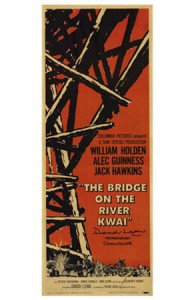
Madness! MADNESS!
David Lean’s most memorable film is most likely Lawrence of Arabia. However his second may be open to some debate. Some may select Doctor Zhivago, but I would select 1957’s Bridge on the River Kwai. On first inspection some would term this a war movie, although in this case that would be incorrect.
Based on a work by French author Pierre Boulle Kwai was, until recently and due to other authors being blacklisted, listed as being written for the screen by Boulle himself exclusively. Michael Wilson and Carl Foreman also played large roles in the screenplay, and recent DVD editions have finally added their names to the on screen credits.
Consistently a critic and audience favorite Kwai is a powerfully gripping film. Even from the defiant entrance of the British prisoners of war into their new home, a Japanese prison camp deep in the jungle, we know something is afoot. The Japanese have been tasked to build a rail bridge across the river and plan to use the entire British contingent, officers included, in hard labor to construct it.
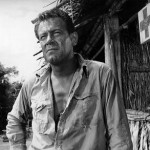 There are a few Americans in the camp as well, including a Commander Shears (William Holden). Shortly after the arrival of the British, Shears escapes to Ceylon. After a spell of luxurious R&R, he is sent back to the Kwai as part of a commando team whose purpose is to destroy the bridge. Of course, as he readies himself construction continues.
There are a few Americans in the camp as well, including a Commander Shears (William Holden). Shortly after the arrival of the British, Shears escapes to Ceylon. After a spell of luxurious R&R, he is sent back to the Kwai as part of a commando team whose purpose is to destroy the bridge. Of course, as he readies himself construction continues.
Colonel Nicholson, after an battle of will with Saito, the commandant of the camp, takes over direct supervision of the construction of the bridge and comes to see it as a justification for his existence. As such the British build a majestic span far beyond the skill of their Japanese masters. (Historically, two bridges were built by British POWs during this period, one of wood and the other of steel. Both were heavily damaged by Allied bombings attacks, although the steel span was repaired and remains in use today.)
As the first train is set to cross the bridge, thus opening it for Japanese military traffic, Shears and the remnants of the commando team arrive to blow the bridge. After a bit of a struggle the bridge is destroyed along with most of the cast. As many of you have doubtless seen the film you will appreciate that I am trying not to give every single nuance here.
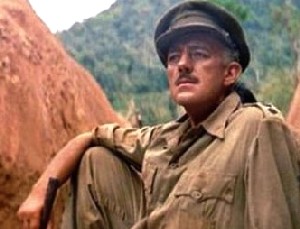 As usual for a Lean film, the casting is superb. There have been countless rumors over who was considered for the various roles; perhaps too much for discussion here. We are left with Alec Guinness as British officer Colonel Nicholson and William Holden as Commander Shears. Among the films seven Academy Awards was one for Guinness as Best Actor. To me, Guinness always seems to overact just a bit here, most notably with his exaggerated walks both on leaving solitary confinement and ultimate demise. Perhaps just me.
As usual for a Lean film, the casting is superb. There have been countless rumors over who was considered for the various roles; perhaps too much for discussion here. We are left with Alec Guinness as British officer Colonel Nicholson and William Holden as Commander Shears. Among the films seven Academy Awards was one for Guinness as Best Actor. To me, Guinness always seems to overact just a bit here, most notably with his exaggerated walks both on leaving solitary confinement and ultimate demise. Perhaps just me.
However, from my view Holden steals the picture with his typical snarky humor. He has several great lines here including one involving his likelihood of surviving a parachute jump – with or without a parachute.
Kwai just entered the blu-ray arena a few weeks ago. It comes in a sharp package, perhaps not quite up to the standards of Warner Brothers, but definitely very nice. The discs are housed in a book very similar to those of rival Warner. The book itself is in a sharp heavy duty slipcase with the original release artwork highlighted. Being an aficionado of movie posters, I find this an improvement over the various artwork used for the previous standard DVD releases.
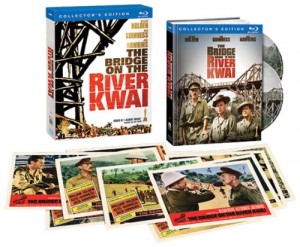 Supplemental materials are for the most part ported over from previous releases, but are quite good. There is an additional new clip of Holden introducing the film at it’s premiere. You also get a reprint of the original souvenir booklet and a selection of stills. Not sure that in itself is a great reason to grab this but the quality of the feature itself is.
Supplemental materials are for the most part ported over from previous releases, but are quite good. There is an additional new clip of Holden introducing the film at it’s premiere. You also get a reprint of the original souvenir booklet and a selection of stills. Not sure that in itself is a great reason to grab this but the quality of the feature itself is.
Sony has performed an extensive 4K restoration of Kwai and the results are breathtaking. The film has never looked so good and even the titles are sharply focused as never before. And titles usually are not that important, but the difference here is alarmingly good. Detail is superb and blacks are suitably dark without being overpowerful. There is still a slight bit of grain throughout and except for a few very momentary blips in softer shots this is a perfect release.
One downfall of the restoration, though purely from the film’s setting, is that we never get to see much of the full color impact of the restoration team’s fine work. Most of the film is filled with browns of varying shade, from jungle undergrowth, the bridge, the dusty prisoners, the muddy river, and more. No matter.
Sound is also good and, as with most classic films, is kept up front in the center channel. Not on par with current releases but great for a film of this vintage. I did not notice much done with the back or side channels, which is good.
This is a good recommendation to any collection and a good example of how good a classic film can look today if given the right attention and treatment.
Highly Recommended.
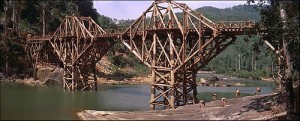
0 thoughts to “The Bridge on the River Kwai (1957)”